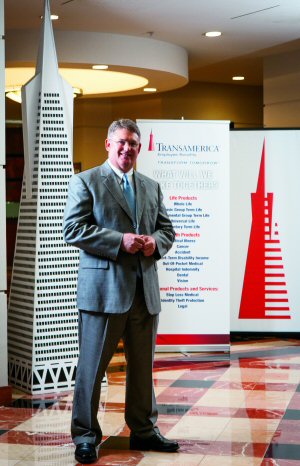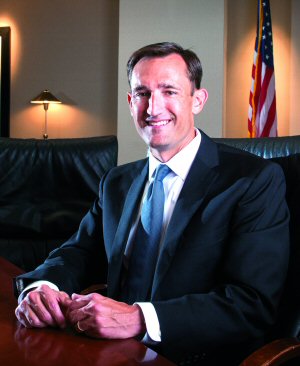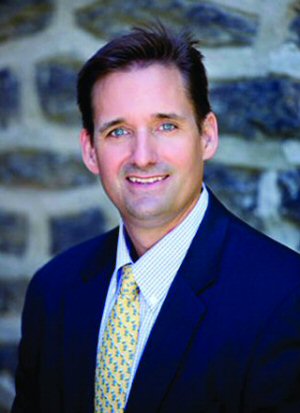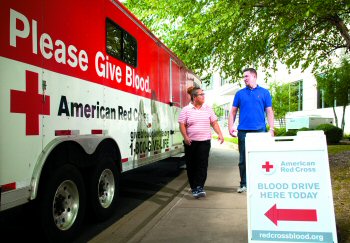

|
| Transamerica Employee Benefts President Randy Clarkson has seen the company’s growth among the fastest of the major carriers. |
Benefits Company
CATCH A WAVE
Transamerica foresees further voluntary growth ?as it builds an integrated benefits solution
By Thomas A. McCoy, CLU
For several years now the voluntary employee benefits business has been growing at a rapid clip. Transamerica Employee Benefits has been among the fastest growing of the major carriers in this market. Eastbridge Consulting ranked Transamerica first in business growth among the large voluntary carriers in 2012, and the company increased its voluntary business by an additional 14% in 2013.
“We’re having another great year of voluntary business growth in 2014,” says Jeff Caldwell, marketing director for Transamerica Employee Benefits.
More important for benefits brokers, Caldwell points to evidence that the overall voluntary growth wave is a long way from cresting. Harris Interactive conducted a national study for Transamerica a year ago which found that almost half (47%) of full-time U.S. employees covered by benefit plans had not been offered an additional voluntary product since health care reform was enacted in 2010.
“On some levels that’s great news for producers and benefit advisors,” says Caldwell. “They’re not too late to the game. The time to sell really is right now.”
Almost two thirds (62%) of the study respondents said they were at least somewhat likely to purchase voluntary products to respond to their family’s health care needs. Almost half (46%) said it was likely or very likely that they would remain at their current employer primarily due to the voluntary products package offered. The study data was compiled online by polling more than 2,000 employees.
In response to the continuing interest in voluntary products, Transamerica has recruited additional independent producers and strengthened its producer retention initiatives. John Stanley, chief marketing officer of Transamerica Employee Benefits, explains how its producer force is evolving along with growth in the market.
“Five years ago, we focused much of our effort on working with specialty brokers who cater to the voluntary benefits industry—those who offer specific products to a defined demographic or market segment. Today we’ve expanded our target audience of producers. We’ve seen greater adoption by traditional employee benefits brokers and consultants to use voluntary benefits as part of the overall employee benefits solution for employers, rather than a ‘nice to have’ or ‘add on.’ ”
“We also have great resources to help train agents in property/casualty-based firms to sell voluntary benefits products,” says Caldwell. “We recognize that it can bechallenging for those who aren’t as familiar with supplemental health and life products. But these products represent a huge opportunity for them.”

|
| “We offer plan design flexibility that allows a producer to craft a strategy where voluntary benefits are not just supplemental, but instrumental in putting together a complete employee benefits package.”
—Jeff Caldwell |

|
| “We’re one of the only voluntary, supplemental benefits companies that can provide benefits for part-time, hourly and full-time employees.”
—John Stanley |
Transamerica has built its voluntary product line in tandem with the changes in the employer-paid health care market, both before and since implementation of the Affordable Care Act. “As we’ve seen deductibles increase and premiums continue to rise, those gaps have really created opportunities for our supplemental health products to fill the void and help offer financial protection for employees,” Caldwell says.
Transamerica’s approach is to integrate voluntary product choices into the total benefits package of an employer, no matter what the employer’s major medical plan looks like. An employer can offer a wide range of voluntary product options, combinations and limits for an employee to choose from.
“For example, we offer over 4 million different accident plan designs,” says Caldwell. “With that kind of design flexibility, producers can tailor a benefits strategy that meets the needs of employees instead of just saying, ‘Here’s an off the shelf product. Good luck.’ A producer can craft a benefits strategy where voluntary benefits are not just supplemental, but instrumental in putting together a complete employee benefits package.
“Design flexibility doesn’t necessarily simplify the sales process for producers,” Caldwell adds. “What it does,” he emphasizes, “is give producers the opportunity to be more consultative. With health care reform in effect, the producer can say to the employer, ‘I can craft a strategy around what you’re trying to do, regardless of where your employees are buying major medical coverage.’”
For today’s producer, using a consultative approach is a good fit for market conditions, Caldwell believes. “Human resource departments aren’t getting any bigger. The producer who is the go-to resource for an employer has a huge advantage right now.”
Transamerica writes groups as small as two employees to those with thousands of employees. “We take a customized approach, from proposal to enrollment, to make sure a case is implemented successfully,” says Caldwell. “As employers migrate to a self-service enrollment platform, it becomes even more difficult for employees to sort through their choices.”
To help them with these choices, the company uses educational videos, email campaigns, decision support modules, and other employee engagement tools including traditional paper communication. “As you’re looking at younger audiences, there are different media available to reach them. Email isn’t necessarily the best way to communicate with millennials anymore. At the end of the day, we want employees to be fully educated in making their benefits decisions,” says Caldwell.
Transamerica has further simplified the employee benefits selection process for some products by bundling two or more products into a package. “Product packaging has really taken off for us in the last four years,” says Caldwell. “Consumers see the value of packaging just as they do with other products they buy such as Internet, phone and cable services. So transferring that concept to the benefits world made sense. It’s been an easy way for us to offer a successful strategy for producers in the small group health market.”
One bundled product, myPacksm, combines group term life with critical illness and off-the-job accident with disability income. The other bundled product, HealthPak, is designed to bridge coverage gaps when an employer is moving from a low-deductible to a high-deductible major medical plan. It links critical illness and accident products to any other voluntary product that can serve this purpose. The employee enrolls in HealthPak at the same time he enrolls in the employer’s major medical plan.
“Most of the time this is an employer-paid strategy,” Caldwell explains. “The employer contributes the same percentage to HealthPak that it does to the employees’ major medical coverage. So, if the employer is paying 75% of the premium for the major medical plan, it also would contribute 75% toward this product package.”
The bundled products are designed for companies with under 100 employees, Stanley points out. “Our experience in developing these products for the small group market has taught us a lot about serving that market.”
Transamerica serves groups that vary widely in size and service requirements. “We can provide a comprehensive solution to all segments of the employee population,” says Stanley. “We’re one of the only voluntary, supplemental benefits companies that can provide benefits for part-time, hourly and full-time employees,” he notes.
For the company’s traditional employee benefits accounts, 50 sales representatives serve as the first point of contact for brokers throughout the nation. Once an account is in the process of being set up, the producer and HR manager begin working with a client relationship manager in the home office. The CRM supervises the group paperwork, enrollment communications and education, and initial billing.
Three years ago Transamerica Employee Benefits created its National Accounts Practice, which tailors its services to brokers with large, multi-state clients. “These employers and their brokers have different needs and expectations from those of more traditional accounts,” says Stanley. “By working with them we’ve learned a lot that will help us in creating the next generation of products and services. That’s consistent with how we’ve built our smaller market business as well.”
Transamerica is positioned to capitalize on the opportunities presented by the formation of insurance exchanges. Its National Accounts Practice has helped it formulate a strategy for working with exchanges.
“We started developing an exchange strategy three years ago,” Stanley states. “We’ve broadened our administrative platform to support the needs of brokers and consultants (who all have their own strategies and technology platforms for identifying and working with an exchange). We are seeing significant momentum, and we believe that we are in a good position to leverage our investments and support the growth of this market-driven strategy.”
“An exchange has the potential to simplify what can be a complex benefit selection process,” Stanley observes. “Employees face difficult choices as more financial responsibility is placed on them. Exchanges that provide decision support tools and offer product bundles appear to have an advantage.”
Whatever brokers and companies may need to do to respond to market changes over the next few years, it’s clear from the Transamerica study that there are huge opportunities in the voluntary benefits market. Transamerica Employee Benefits is determined to adapt its wide range of products and services to market demands.
“The last three years of wading through the uncertainty of the Affordable Care Act has forced many companies to take a hard look at their business and determine what direction they will need to take to support the needs of their customers,” says Stanley. “It’s been beneficial for benefits providers in the sense that it teaches us to always be in touch with the fast-changing market, and to adjust our products and services to serve customer needs.”

|

|
| Transamerica’s growth has required attracting and retaining quality people. The company culture includes creating an atmosphere where employees are able to find a balance of work and wellness. | Company employees give back to the local community by participating in philanthropic projects. |
The author
Thomas A. McCoy, CLU, retired in 2013 as editor-in-chief of Rough Notes magazine.